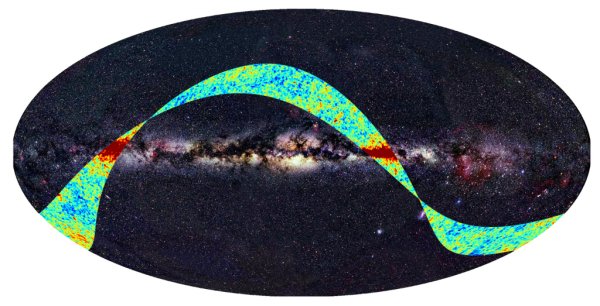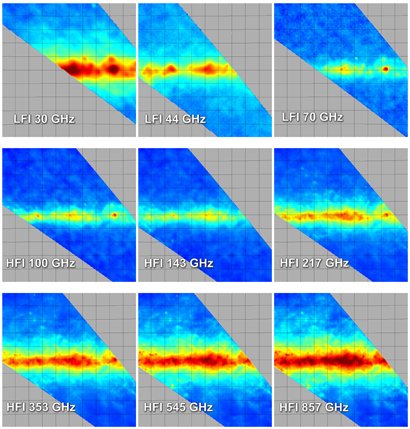ESA's 'time machine' takes first glimpse into the past
17 September 2009

Planck's first light survey superposed on an all-sky map (more).
Image Credit: ESA, LFI & HFI Consortia (Planck), Background image: Axel Mellinger
The Planck space observatory, ESA's mission to study the early Universe, has successfully completed its initial test survey of the sky. This has confirmed that both the sophisticated cooling system and the scientific instruments, some of which Jodrell Bank Centre for Astrophysics played a key role in building, are working well. Following the successful survey, Planck has now embarked on its 15 month mission to map the structure of the Cosmic Microwave Background radiation (CMB) - the relic radiation from the Big Bang.
Staff at The University of Manchester designed and built vital components at the heart of the Planck satellite. These low noise amplifiers are the most sensitive of their type ever built. Professor Richard Davis of the University of Manchester, and principal investigator of the UK's contribution to Planck's Low Frequency Instrument, said:
"In the 16 years since Planck’s development started, this is the most exciting time. The wonderful thing is that Planck, from its vantage point one million miles from Earth, is now producing images of the creation of the Universe - the so-called Big Bang - with a clarity never seen by mankind."
The 'first light' survey started on the 13th August and ran for a two-week period. During this time Planck observed the Universe continuously, producing maps of a strip of the sky for each of Planck's 9 frequencies. The plane of our own Milky Way galaxy can be seen running across the middle of the image, and is visible in the Planck data as the bright red regions. Away from the plane, the tiny fluctuations in the CMB shine through, and these are the main target of the Planck mission.
The properties of the tiny fluctuations in the CMB provide information about the earliest moments of the Universe's existence and how it evolved to become the Universe we see today. Planck is looking with finer resolution and greater sensitivity than previous satellites, and will allow the details of the Universe's age and composition to be calculated more precisely than ever before.

Mosaic of maps at 9 different frequencies, showing a 20°x20° part of the Milky Way (more).
Image credit: ESA, LFI and HFI Consortia (Planck)
By observing at all 9 frequencies, Planck can separate the CMB from the light emitted by the Galaxy at the same frequencies. As a result, Planck will make unprecedented observations of our own Galaxy, detecting and characterising both gas and dust. Having maps at all 9 frequencies allows the individual sources of microwave light to be distinguished better than ever before.
The Planck satellite was launched along with the Herschel satellite on 14th May 2009 from Kourou, French Guiana, on an Ariane 5 rocket. During its 6 week journey to its observation point around Lagrange point 2, 1.5 million km (1 million miles) from Earth, the scientific instruments were cooled to extremely low temperatures, making Planck the coldest object in space at just 0.1° above absolute zero (-273.15°C). It took around 6 weeks for Planck to cool down to these low temperatures, after which a further 6 weeks were spent calibrating the instruments.
Routine operations started as soon as the First Light Survey was completed, and surveying will now continue for at least 15 months without a break. In approximately 6 months time, Planck will have completed its first all-sky survey.
Professor Keith Mason, Chief Executive of the Science and Technology Facilities Council, which provides the UK funding for Planck, said:
It's great news that Planck is operating so effectively. UK researchers have invested a great deal of time and skill in this mission and we are all eager to find out what secrets Planck will reveal.
Within its allotted operational life of 15 months, Planck will be able to gather data for two full independent all-sky maps. To fully exploit the high sensitivity of Planck, the data will require a great deal of delicate adjustments and careful analysis. It promises to contain a treasure trove of data that will keep both cosmologists and astrophysicists busy for decades to come.
Notes for editors
UK role in Planck
The UK is playing a major role in the Planck mission, with funding from the Science and Technology Facilities Council (STFC). The UK is the second largest financial contributor to the ESA Science Programme which builds and launches space missions such as Planck using leading-edge technology from the UK space industry. In addition, STFC has invested £17.4M to build instrumentation for Planck.
A number of UK institutes and companies form part of the consortium building the two focal plane instruments, HFI (High Frequency Instrument) and LFI (Low Frequency Instrument). The Jodrell Bank Observatory at The University of Manchester has produced critical elements of the LFI receiver modules. Cardiff University, STFC RAL and SEA have been involved with hardware development for HFI, while various UK research groups including Imperial College London and University of Cambridge form the London Planck Analysis Centre and Cambridge Planck Analysis Centre. These groups are involved with data analysis and simulation for the HFI data analysis and simulation software. More information can be found in the Planck briefing document.
Jodrell role in Planck
Jodrell Bank Centre for Astrophysics (JBCA) is directly involved with the two lowest frequencies of the Low Frequency Instrument, the 30 and 44 GHz radiometers. These have 4 and 6 detectors respectively, operating at 20K (-253.15°C or -423.67°F). The resolution on the sky will be 33 and 23 arc minutes, and the sensitivity 1.6 and 2.4 micro K (1s, over 12 months). The radiometers were built by a European collaboration: the cryogenic low noise amplifiers which are the heart of the radiometers were developed at Jodrell Bank, with help from the University of Birmingham and The Rutherford Appleton Laboratory. Once built they were integrated with the receiver backends (University of Cantabria, Santander and Barcelona), the feed horns (University of Milan, Italy), the phase switches (Instituto de Astrofisica de Canarias, Tenerife), and waveguides (designed in Italy and built in the USA). The radiometers were assembled in Milan by the company Laben, then delivered to the European Space Agency for installation in the Planck Spacecraft.
Some members of JBCA are involved in the other focal instrument, HFI. First at Cardiff University and now at the University of Manchester, they have played a major role in the design, development and calibration of the Focal Plane Unit, in particular the cold optics, in collaboration with the Institut d'Astrophysique Spatiale - France, Maynooth University - Ireland and JPL/Caltech - USA.
The Science and Technology Facilities Council (STFC) has invested £13M in Herschel and £17.4M in Planck.
Contacts
For more information please contact
Dr Stuart Lowe,
The University of Manchester,
+44 (0)161 275 4142.
Julia Short,
Press Officer,
STFC,
+44 (0)1793 442 012


